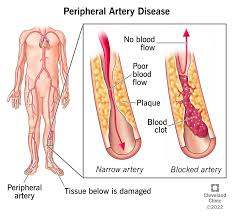A client with chronic peripheral arterial disease (PAD) asks the nurse why this disease developed. Which explanation by the nurse is most accurate?
"Excess sodium from hypertension causes direct injury to the arteries, reducing blood flow and causing obstruction."
"Excess fats in your diet are stored in the lining of the arteries, causing them to constrict."
"A combination of platelets and fats accumulate, narrowing the artery and reducing blood flow to the extremities."
"Injury to the arteries causes them to spasm, reducing blood flow to the extremities."
The Correct Answer is C
Choice A Reason
While hypertension can contribute to the development of PAD, it does not directly cause fats to deposit in the arteries. Hypertension can damage the arterial walls, making them more susceptible to atherosclerosis, but it is not the primary mechanism of PAD development.
Choice B Reason
Excess fats in the diet can contribute to atherosclerosis, which is the accumulation of plaques in the arterial walls. However, the fats do not simply get stored; they combine with other substances, including calcium and inflammatory cells, to form plaques that can restrict blood flow.
Choice C Reason
This statement is the most accurate. PAD is primarily caused by atherosclerosis, which is the buildup of plaques formed by fats, cholesterol, calcium, and other substances in the blood. These plaques can harden and narrow the arteries, leading to reduced blood flow to the extremities. The process can be exacerbated by factors such as smoking, diabetes, and high cholesterol.
Arterial spasms can occur, but they are not the typical cause of chronic PAD. Spasms are more often associated with conditions like Raynaud's phenomenon or can be a response to stress or cold temperatures. PAD is usually a result of progressive atherosclerosis rather than intermittent spasms.

Nursing Test Bank
Naxlex Comprehensive Predictor Exams
Related Questions
Correct Answer is A
Explanation
Choice A Reason:
A positive pregnancy test is crucial information that must be reported immediately as it has significant implications for the patient's health and treatment options. Pregnancy can impact the results of a Schilling's test, which is used to diagnose B12 deficiency anemia, as pregnancy itself can cause changes in B12 metabolism. Therefore, the healthcare provider must be informed to adjust the diagnostic approach and ensure the safety of both the mother and the developing fetus.
Choice B Reason:
While a hemoglobin level of 9.5 g/dL is below the normal range for adult females (11.6 to 15 g/dL) and a hematocrit of 32% is at the lower end of the normal range (36% to 44%)[^10^], these results are consistent with anemia but are not as immediately critical as a positive pregnancy test in the context of a Schilling's test.
Choice C Reason:
A glycosylated hemoglobin (A1c) level of 7.5% is above the normal range (4% to 5.9%), indicating poor blood sugar control over the past two to three months, which could suggest diabetes or prediabetes. However, this is not as urgent as a positive pregnancy test when considering the administration of a Schilling's test.
Choice D Reason:
A serum cholesterol level of 237 mg/dL is considered borderline high (200 to 239 mg/dL), which may increase the risk of heart disease over time. However, this does not require immediate reporting in the context of a Schilling's test for B12 deficiency anemia as compared to a positive pregnancy test.
Correct Answer is A
Explanation
Choice A Reason
Acute compartment syndrome occurs when bleeding or swelling within an enclosed bundle of muscles – known as a muscle compartment – leads to increased pressure. This pressure can impede blood flow to the body tissue and destroy function. The fascia, which is a tough layer of fibrous tissue, does not stretch easily, so any swelling or bleeding can quickly lead to increased pressure.
Choice B Reason
While displaced bones can compress nerves and vessels, this is not the primary mechanism of acute compartment syndrome. Displaced bones are more likely to cause direct injury or impingement, but compartment syndrome specifically refers to the pressure build-up within a muscle compartment that affects circulation and tissue viability.
Choice C Reason
Interruption of blood supply to the bone is a serious concern and can lead to conditions such as avascular necrosis. However, in the context of acute compartment syndrome, the primary issue is the pressure within the muscle compartment rather than direct disruption of blood supply to the bone.
Choice D Reason
Compression of muscle tissue can restrict blood flow to the area, which is a part of the pathophysiology of compartment syndrome. However, the compression is a result of increased pressure within the compartment, not the primary cause. The increased pressure is due to bleeding and swelling, which is why choice A is the most accurate description.
Whether you are a student looking to ace your exams or a practicing nurse seeking to enhance your expertise , our nursing education contents will empower you with the confidence and competence to make a difference in the lives of patients and become a respected leader in the healthcare field.
Visit Naxlex, invest in your future and unlock endless possibilities with our unparalleled nursing education contents today
Report Wrong Answer on the Current Question
Do you disagree with the answer? If yes, what is your expected answer? Explain.
Kindly be descriptive with the issue you are facing.
